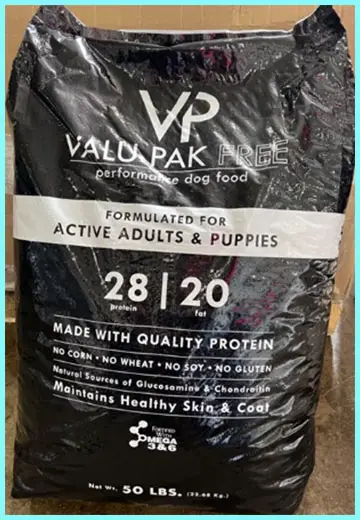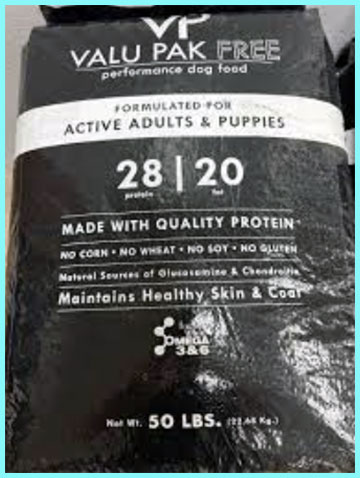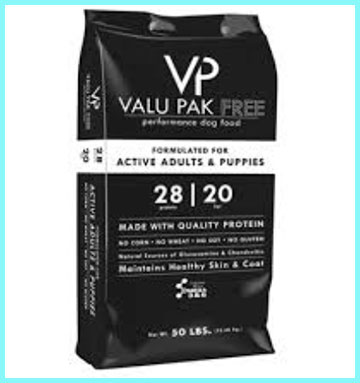I run a small kennel with four high-drive, high-energy working dogs. Their “job” is to run, and my job is to fuel them properly. For years, I was trapped in a cycle: I’d buy the shiniest, most expensive, grain-free, “ancestral diet” bags from the boutique store, and my dogs’ performance would be… just okay.
Their coats were dull, their energy was inconsistent, and I was spending a fortune. Then, a fellow trainer, a guy I’d trusted for decades, pointed to a simple, no-frills 50-pound bag in his feed room: Valu-Pak. If you’re tired of marketing hype and just want a food that delivers high-octane performance at a cost that makes sense, you need to read my story.
My Experience With Valu-Pak Dog Food
Let me introduce my crew: two Belgian Malinois and two German Shorthaired Pointers. This is not a “walk around the block” group. We are out for hours every single day, training, running, and working. Their nutritional needs are off the charts, and I was failing them while simultaneously bankrupting myself.

I was feeding them a “premium,” salmon-and-sweet-potato, grain-free food that cost over $100 a bag.
It looked great on paper. But in practice? My Mals had itchy skin, and my GSPs had soft, inconsistent stools.
They just weren’t thriving. They were maintaining, but they didn’t have that “pop” I was looking for.
I was frustrated, and I was tired of being told that the answer was an even more expensive bag.
I took my trainer’s advice and drove to my local feed and farm supply store. There it was: the “black bag” of Valu-Pak Free 28-20. The bag itself was a joke. It’s not pretty.
It’s not matte, with a beautiful photo. It’s a simple, glossy bag. It cost about half of what I was currently paying.
I read the label, feeling skeptical. The first two ingredients: “Chicken By-Product Meal” and “Pork Meal.” My “boutique food” brain recoiled. Where was the “Deboned Chicken”? Where was the “Fresh-Caught Salmon”? Then I looked at the guaranteed analysis: 28% protein, 20% fat. This was a performance ratio. And the 28% protein was coming from those two dense, animal-based meal sources. The 20% fat was from chicken. It was built like a drag-racing car: all engine, no fluff.
I decided to try it. The transition was the first shock. I followed the standard 10-day gradual mix-in. On day three, my pickiest Malinois, “Shadow,” who would normally graze all day, was picking the new kibble out of her bowl and eating it first. She was actively seeking it out. By the end of the transition, all four dogs were licking their bowls clean. They loved it. The kibble itself is small, dense, and has a rich, meaty smell. It’s not a light, airy, carb-filled puff.
But the real change happened around week four.
The first thing I noticed was the stool. I know, it’s not glamorous, but as a dog owner, you become an expert. For the first time, all four dogs were producing small, firm, consistent, and predictable stools. The GSP’s digestive issues vanished. Completely.
The second change was their coats. My Mals’ itchy, flaky skin? Gone. Their coats became deep, rich, and so shiny they looked wet. It was like their bodies were finally getting the high-quality fats they had been craving.
The final change was the performance. That was the “pop” I was looking for. Their endurance went through the roof. Their recovery times were faster. They weren’t hitting that 2-hour wall anymore. They were just… on. They were fueled.
I have now been feeding Valu-Pak for three straight years. I will never go back. I’ve made peace with the “unsexy” ingredients because I’ve seen the results. I’ve learned that “Chicken By-Product Meal” isn’t a bad word; it’s a highly digestible source of protein and nutrients (like organs and cartilage) that my dogs need. This food is a no-nonsense, high-performance, affordable fuel, and my dogs have never been healthier.
Read More: My Thoughts On ZIWI Peak Canned Wet Dog Food
Pros Of Valu-Pak Dog Food
- It’s A No-Nonsense, High-Performance Formula: This is the main reason I use it. Valu-Pak doesn’t mess around with marketing trends; it focuses on macros. My “go-to” formula, the Valu-Pak Free 28-20, means 28% protein and 20% fat. This is a dream ratio for working dogs, sporting breeds, or any dog with high energy needs. The high fat content (20%) provides the sustained, long-burn energy my dogs need for endurance, while the 28% protein is perfect for muscle repair and recovery. It’s pure, rocket fuel in a kibble. The “red bag” 24-20 is just as good, offering a slightly lower protein point for dogs that might not need the full 28%. This food is built for performance, not for sitting on a couch.
- High-Quality, Animal-Based Protein: This is the secret to its success. The “boutique” brands love to advertise “Fresh Deboned Chicken” as the first ingredient. That sounds great, but “fresh” meat is 70-80% water. When you cook that down into a dry kibble, the actual protein content drops dramatically. Valu-Pak starts its ingredient list with “Chicken By-Product Meal” and “Pork Meal.” A “meal” is a concentrated, rendered, protein-dense powder that has had the water and fat removed. It’s a far more potent and concentrated source of protein. And “by-product meal” isn’t just “feathers and beaks”; it’s a nutrient-rich blend of organs, cartilage (a natural source of glucosamine), and other parts that my dog’s ancestors would have eaten. The protein is coming from animals, not from potatoes or peas.
- Formulated Free Of Major Allergens: This was the game-changer for my Malinois. The “Free” line (like the black bag 28-20) is formulated without corn, wheat, soy, or gluten. These are the most common culprits for skin and digestive issues in sensitive dogs. My dogs’ itchy skin and upset stomachs were gone within a month of switching. They use whole-grain brown rice and sorghum as the primary carbohydrates, which are highly digestible and provide consistent, slow-release energy. It’s not “grain-free”—a trend that has become very controversial—but it’s “clean” of the junk fillers that cause so many problems.
- Unbeatable Value And Cost-Effectiveness: Let’s just be honest: this is a huge pro. I’m feeding four large, active dogs. A 50-pound bag of Valu-Pak costs me a fraction of what I was paying for a 30-pound bag of the “premium” stuff. I am getting better results, healthier dogs, and higher performance for about half the price. The brand doesn’t spend millions on shiny bags or Super Bowl commercials. It’s a “no-frills” product, and that saving is passed directly to me. For kennels, breeders, or anyone with a multi-dog household, this food is an absolute economic lifesaver.
Cons Of Valu-Pak Dog Food

- The “Unsexy” Ingredient Panel
- Use Of By-Products And Vague “Meals”: This is the number one hurdle for new buyers. The term “Chicken By-Product Meal” makes people nervous. We’ve been marketed to believe this is a “bad” ingredient. While it’s highly nutritious, it’s not specific. You don’t know the exact ratio of organs to cartilage. Likewise, some of their other formulas might use a non-specific “Meat Meal,” which is a mix of rendered mammal tissues. If you have a dog with a specific allergy to, say, beef, a vague “meat meal” is a gamble you can’t take. I wish they had more transparency here.
- It’s Not A “Limited Ingredient” Diet: While the “Free” line removes corn, wheat, and soy, it’s not a true Limited Ingredient Diet (LID). It still has multiple protein sources (chicken, pork) and multiple carbohydrate sources. If you have a dog with severe, complex food allergies and your vet is trying to isolate a single protein, this is not the food for you. It’s “allergen-friendly” for common sensitivities, but it’s not a hypoallergenic or prescription diet.
- Not Designed For All Dogs
- This Is “Hot” Food (High-Calorie): These formulas are dense. The 28-20 formula is packed with 430 calories per cup. This is a pro for my working dogs, but it would be a disaster for a lazy Basset Hound or a couch-potato Pug. It is incredibly easy to overfeed this food, and you will have an obese dog in a hurry. If you are not actively working, sporting, or hiking with your dog on a regular basis, this is probably too much food. It is not a “one-size-fits-all” product.
- Lack Of Specialized Formulas: Valu-Pak’s strength is its simplicity. They do one thing well: performance food. They do not have a “Senior” formula, a “Weight-Loss” formula, a “Small-Breed” formula, or a “Puppy” formula (though the 28-20 and 24-20 are AAFCO-approved for “All Life Stages,” which I’ll get to). If you are looking for a food specifically tailored to a life stage or a health condition, you will not find it here.
- Availability And Accessibility
- You Won’t Find This At PetSmart: This is a “feed store” brand. You will not find Valu-Pak at your local Petco or on the shelves of your high-end boutique. You have to find a local farm supply, feed and seed, or kennel supply store that carries it. For me, it’s a 30-minute drive. While it is available online through sites like Chewy, the shipping on a 50-pound bag can be expensive and sometimes unreliable, wiping out the “value” part of the name. This inconvenience is a real con for the average pet owner.
Maintenance Tips For Valu-Pak Dog Food

- Storage And Feeding (The Big Two)
- You MUST Get An Airtight, Varmint-Proof Container: This is my most important tip. You are buying a 50-pound bag of high-fat food. The fat is what makes it taste good to your dog, and it’s also what will go rancid and attract pests. You cannot just roll the top of this bag down and use a chip clip. I use a Vittles Vault. It’s an airtight, screw-top, heavy-duty plastic container. This does two critical things: 1) It keeps the food 100% fresh, protecting the fats from oxidizing and losing their potency. 2) It keeps rodents, bugs, and my other dogs from tearing into a 50-pound buffet.
- Measure Every Meal. No, Really. Measure. This food is rocket fuel, and it is dense. The 28-20 bag has 430 calories per cup. My old “premium” brand had 350. If I fed my dogs the same volume (e.g., two scoops) of Valu-Pak, I would be overfeeding them by hundreds of calories a day. You must read the feeding guidelines, start at the low end for your dog’s weight and activity level, and use a standard 8-ounce measuring cup. You have to feed by weight and calories, not by volume.
- The “All Life Stages” Loophole (For Puppies): The bag says it’s for “All Life Stages,” which includes puppies. This is true, but it requires care. This food is not formulated for “large breed puppy growth,” which is a specific AAFCO standard for controlled calcium/phosphorus ratios to prevent joint issues. I do raise my GSP pups on the 28-20, but I am extremely careful to keep them lean. You cannot let a large-breed puppy get “fat” on this food; you risk developmental orthopedic disease. My advice: talk to your vet first.
- Transitioning And Upkeep
- A Slow Transition Is A Non-Negotiable: You cannot just swap from a 22/10 chicken-and-rice food to a 28/20 pork-and-chicken food overnight. You will have a digestive explosion on your hands. The high-fat content can be a shock to your dog’s system and can even trigger pancreatitis if done too fast. You must do a slow, 10-14 day transition. I do 25% new food for 3-4 days, then 50% for 3-4 days, then 75% for 3-4 days. This gives their gut bacteria and pancreas time to adapt to the new, rich formula.
- Clean Your Food Scoops And Bins: This is a tip I learned the hard way. The high-fat content that makes the kibble so palatable also leaves an oily residue on everything it touches. That residue will go rancid over time. Every time I finish a 50-pound bag, I take my giant Vittles Vault and my metal food scoop and I wash them thoroughly with hot, soapy water. If you just dump a new bag on top of the old, rancid, oily crumbs, you’re contaminating your fresh food.
- Watch Your Dog, Not Just The Bag: The feeding chart on the bag is a starting point, nothing more. It’s a suggestion from a computer. You have to be a dog owner. Look at your dog. Can you feel their ribs but not see them? Do they have a visible “tuck” at their waist? If the answer is yes, your weight is perfect. If they are starting to look like a tube, you need to cut back their food by 1/4 cup, no matter what the bag says. You are in charge of their caloric intake, and this food requires you to be vigilant.
Comparison With Other Brands

- Versus Boutique “Grain-Free” BrandsWhen I compare Valu-Pak 28-20 to a brand like Taste of the Wild or Orijen, the difference is in philosophy. Orijen is a “biologically appropriate” food with 80% fresh meat and a 38% protein content. It’s an incredible food, but it’s also $130 a bag, and the protein source is often “exotic” (bison, venison, etc.) or legume-based (peas, lentils). Valu-Pak’s philosophy is simpler: performance macros. It uses proven, calorie-dense, animal-based meals (pork, chicken) and digestible grains (rice, sorghum) to deliver a 28/20 ratio for work. Orijen is for the owner who wants a “wolf diet.” Valu-Pak is for the owner who wants a “sled dog diet.”
- Versus Other “Performance” Feed Store BrandsThis is the real competition. When I’m at the feed store, my other main choice is Victor Pet Food, specifically their “Hi-Pro Plus” formula. Victor is also a 30/20 food, is highly respected in the working-dog community, and has a great, no-recall history. The main difference is that Victor uses a “multi-protein” approach (beef, chicken, pork, fish) and a “V-Pro” blend of supplements. Valu-Pak is a simpler, more “meat-and-potatoes” formula. My dogs did great on Victor, but their coats and stools are just slightly better on the Valu-Pak. At this level, it’s like choosing between a Ford or a Chevy truck; both are great, and it just comes down to which one your dog “runs” best on.
- Versus Common “Grocery Store” BrandsWhen I put Valu-Pak next to a bag of Purina Dog Chow or Pedigree, there is no comparison. It’s a different species. Those brands are typically corn-first formulas with lower protein (21-22%) and much lower fat (10-12%). They are loaded with fillers and artificial colors. Valu-Pak’s ingredients (pork meal, chicken meal, brown rice) are in a completely different league. It’s a “premium” food at a “value” price. The only grocery-store-level brand that even tries to compete on performance is Purina Pro Plan Sport, which is an excellent 30/20 food, but it comes at a much higher, non-feed-store price point.
Also Read: My Thoughts On Nutro Natural Choice Dog Food
Frequently Asked Questions (FAQ)
Valu-Pak is made by Specialty Feeds, a family-owned and operated pet food company based in the United States. They have been in business for over 50 years.
“Healthiest” is different for every dog. The “best” brands are typically those that invest heavily in nutritional research and own their own manufacturing plants, like Hill’s Science Diet, Royal Canin, and Purina Pro Plan. For “clean” ingredients, brands like Open Farm or Taste of the Wild are highly rated.
This depends on the formula. The most popular performance bags (like the 28-20 and 24-20) use a combination of Chicken By-Product Meal and Pork Meal as the primary, concentrated animal protein sources.
As of my research, Valu-Pak has a long and impressive history of no recalls. This is a significant factor for many owners who prioritize brand safety and reliability.
Conclusion
Valu-Pak is not the right food for every dog, but it is the perfect food for mine. It’s a no-frills, no-hype, high-octane fuel that has given my working dogs better coats, more consistent energy, and perfect digestion, all at a price that lets me sleep at night. If you own a high-energy breed, a sporting dog, or run a kennel, and you’re tired of paying for marketing gimmicks, you owe it to your dogs (and your wallet) to find a feed store and buy a bag. Your dogs will thank you.
